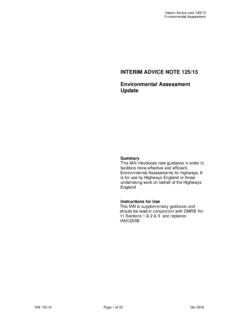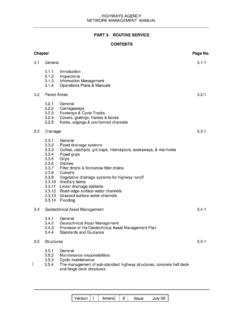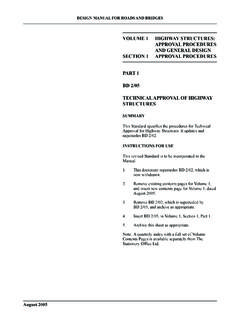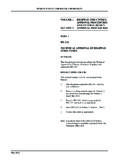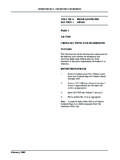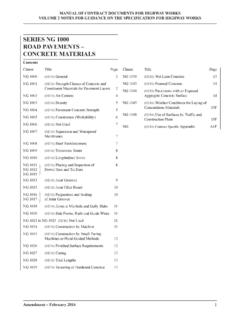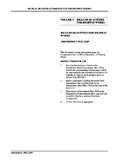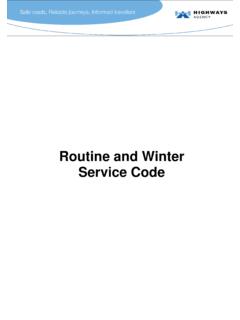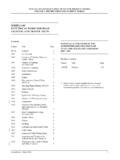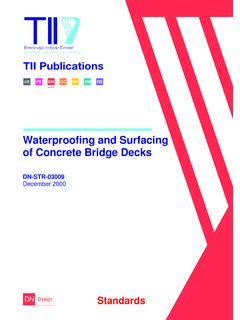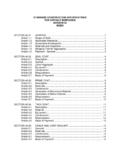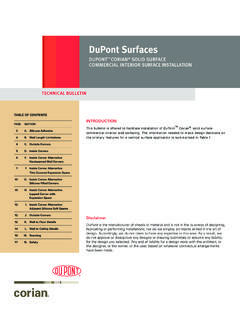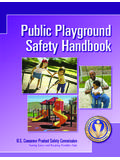Transcription of DESIGN MANUAL FOR ROADS AND BRIDGES
1 May 1999 DESIGN MANUAL FOR ROADS AND BRIDGESVOLUME 7 PAVEMENT DESIGN ANDMAINTENANCESECTION 5 surfacing ANDSURFACING MATERIALSPART 2HD 37/99 AMENDMENT NO 1 BITUMINOUS surfacing MATERIALSAND TECHNIQUESSUMMARYThis amendment is a correction to Chapter 8, Table of use for surface dressing FOR USE1. Remove existing page 8/8, dated February 1999,from Volume 7, Section 5, Part 2, Chapter 8 andarchive as Insert page 8/8 dated May Enter the details of the amendment on theRegistration of Amendments sheet, sign and dateto confirm the amendment has been Archive this sheet as :A quarterly index with a full set of VolumeContents Pages is available separately from TheStationery Office 1999 DESIGN MANUAL FOR ROADS AND BRIDGESVOLUME 7 PAVEMENT DESIGN ANDMAINTENANCESECTION 5 surfacing ANDSURFACING MATERIALSPART 2HD 37/99 BITUMINOUS surfacing MATERIALSAND TECHNIQUESSUMMARYThis Advice Note gives advice on the suitability,specification, laying and testing of bituminous surfacecourses.
2 It supersedes HD 37/97 and also Chapters 4and 5 of HD 27/94, revised versions of which areincorporated into Chapters 2 and 5 of HD 37 FOR USE1. Remove HD 37/97 from Volume 7, Section 5,Part 2, which is superseded by HD 37/99, andarchive as Insert HD 37/97 into Volume 7, Section 5, Part Archive this sheet as :A quarterly index with a full set of VolumeContents Pages is available separately from TheStationery Office Ltd. HD 37/99 DESIGN MANUAL for Roadsand BridgesVolume 7: Pavement Designand MaintenanceBituminous SurfacingMaterials and TechniquesTHE HIGHWAYS AGENCYTHE SCOTTISH OFFICE DEVELOPMENT DEPARTMENTTHE WELSH OFFICEY SWYDDFA GYMREIGTHE DEPARTMENT OF THE ENVIRONMENT FORNORTHERN IRELANDDESIGN MANUAL FOR ROADS AND BRIDGESS ummary: This Advice Note gives advice on the suitability, specification, laying andtesting of bituminous surface courses. It supersedes HD 37/97,HD 27/94, Chapters 4 & 5, and HD 28/94.
3 Chapter 7 Section 5 Part 2 HD 37/99 February 1999 REGISTRATION OF AMENDMENTSA mend Page No Signature & Date of Amend Page No Signature & Date ofNo incorporation of No incorporation ofamendments amendmentsRegistration of AmendmentsVolume 7 Section 5 Part 2 HD 37/99 February 1999 REGISTRATION OF AMENDMENTSA mend Page No Signature & Date of Amend Page No Signature & Date ofNo incorporation of No incorporation ofamendments amendmentsRegistration of AmendmentsVOLUME 7 PAVEMENT DESIGN ANDMAINTENANCESECTION 5 surfacing ANDSURFACING MATERIALSPART 2HD 37/99 BITUMINOUS surfacing MATERIALSAND TECHNIQUESC ontentsChapter1.
4 Introduction2. Laying Bituminous Surface Courses3. Binders and Binder Modifiers4. Hot Rolled AsphaltAnnex A: Method for Determination of Loss ofChippings and Proportion of BrokenChippings5. Porous Asphalt6. Thin Wearing Course Systems7. Stone Mastic Asphalt8. Surface Dressing9. High Friction Surfacing10. Slurry surfacing and Micro-surfacing11. Retexturing (Bituminous)12. Not currently used13. Miscellaneous Surface Courses and Treatments14. References15. EnquiriesDESIGN MANUAL FOR ROADS AND BRIDGESF ebruary 1999 Volume 7 Section 5 Part 2 HD 37/99 February 1 IntroductionHigh Stone Content Gap-graded High stone content materials with aggregateinterlock can be divided into two main types: Those with very little or no fine aggregate(eg Porous Asphalt - PA), and Those in which the voids between the coarseaggregate particles are largely filled with a masticof fine sand, filler and binder, often reinforcedwith fibres or polymer (eg a stone mastic asphalt -SMA).
5 Many of the new thin surfacing materials fall intothis second type. The high strength of these materials isproduced by the stone skeleton and they are inherentlyresistant to rutting. Because the stone skeleton is soimportant the aggregates used in these materials must bestrong and hard, and must have a consistent shape andgrading, or the final mix will vary in On ROADS where the width varies they are best laidusing a paver with a variable width screed as they canbe difficult to lay by hand and the overall grading needsclose control. When properly compacted, densematerials such as SMA can be very durable, because airvoids are low and the binder film thickness is generallyhigh. If the air void content is too low however,achieving and retaining surface texture can beproblematic and the SMA can be prone to For long life, porous materials depend on thecontinuing integrity of the binder film. There are twomain factors operating, adhesion of the binder to theaggregate and weathering of the binder.
6 Some aggregateshave a better affinity for bitumen than others and wherethere is doubt, (eg with quartzites), then adhesion agentsshould be used. The weathering of the binder and themeans of overcoming the problem are dealt with in moredetail in Chapter 5 of this Macadams or Asphaltic Materials with a continuous grading are oftencalled asphaltic concretes or macadams. The currentCEN name for all these types of material is asphalticconcrete. All the dense and close graded macadams inBS 4987 fall into this group. Macadams are notgenerally used as surface courses on trunk ROADS as theysuffer from a number of disadvantages which areoutlined in Chapter 13 of this This Part gives advice on the suitability,specification, laying and testing of bituminous surfacecourses. It covers all materials using bituminous bindersranging from veneer coats like surface dressing andslurry surfacing to heavy duty surfacing material such ashot rolled asphalt.
7 It also includes high frictionsurfacing, retexturing of bituminous materials andrecycling using the Remix and Repave This Part shall be used forthwith on allschemes for the construction, improvement andmaintenance of trunk ROADS including motorways,currently being prepared, provided that, in theopinion of the Overseeing Organisation, this wouldnot result in significant additional expense or organisations should confirm its applicationto particular schemes with the of Bituminous surfacing There are essentially three basic types ofpremixed bituminous material. Those with:- High stone content, full coarse aggregateinterlock, and a gap grading (eg SMA); A continuous grading (eg DBM); A rich mortar and a gap grading where the coarseaggregate does not interlock (eg HRA);Intermediate materials exist such as a high stone contenthot rolled asphalt with crushed rock fines, which fallsbetween the last two types.
8 Slurry surfacing , andparticularly micro- surfacing , normally have acontinuous grading. Single chipping surface dressingdoes not fall into any of these classifications, but multi-layer dressings (like racked in, double and sandwichdressings) can be considered as a type of high stonecontent material with full coarse aggregate 7 Section 5 Part 2 HD 37/99 February 19991/2 Chapter The mixes are designed to give a denseaggregate matrix, often based on the Fuller this means that the voids in the mineralaggregate (VMA) are low, and in order to avoid fillingall the voids with binder (making an unstable materialprone to deformation) the binder content must be keptrelatively low. This results in a relatively thin binder filmthickness, which reduces its durability. However a thinbinder film is not generally a problem in layers protectedfrom the weather, which is why materials of this typemake excellent load spreading layers in the roadbase in this group are sensitive to variationsin grading and binder content and production will bemonitored by the supplier under the QA Sector schemeto ensure consistency.
9 They generally have lowworkability and therefore need good compaction ifdurability is to be achieved. When properly compacted,the texture depth obtainable is very low making themunsuitable as surfacing for high speed Rolled stone content gap graded materials arenormally referred to as hot rolled asphalt and arecovered by BS 594. They usually have a high bindercontent and low voids. They depend for their rutresistance on the sand/filler/binder matrix and, ofnecessity, the binders are hard (low penetration grade). the requirements for higher stability andretention of high texture depth, asphalts have tended tobecome less workable, with lower binder contents, andhence are less forgiving of poor workmanship. Thisoften shows up initially as fretting at joints, and jointsealing within the first few years of the life is notunusual. The causes of joint fretting are low bindercontent or over-raking, and poor compaction.
10 It istherefore important that asphalts are adequatelycompacted up to the edge and that this compactionshould be stone content hot rolled asphalt has anominal stone content of 55%, and no chippings arerolled into the of Bituminous Surface of the surface course materials will provideall the desirable requirements for all situations. Asurface course should be the best compromise betweenthe various available properties. The main propertiesrequired are:a) durability,b) resistance to deformation,c) load spreading ability,d) texture depth,e) skidding resistance,f) low noise generationg) the ability to keep water out of the pavementstructure,h) resistance to properties and others are discussed is the ability of a material to resist changesin its properties caused by environmental effects (suchas rain, sun, frost, thaw, temperature changes, oxidation,and also by contaminants deposited on the material(such as oil, mud and animal detritus).
